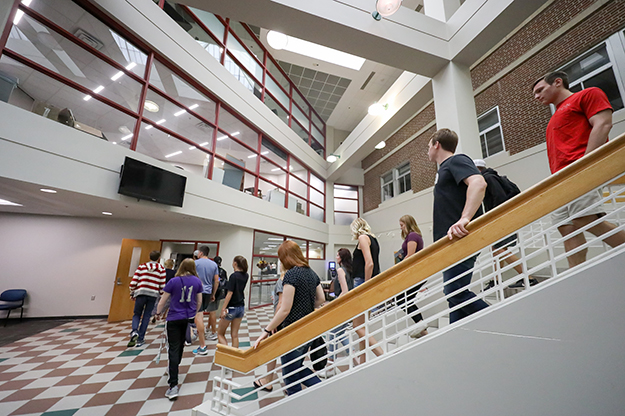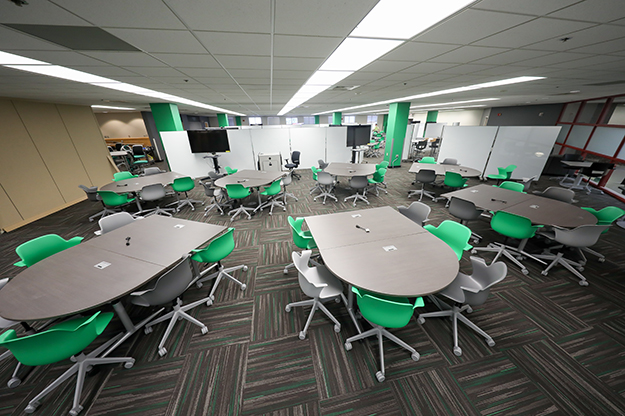UND on the move
Now who’s where? Department and office shuffling aimed at improving the overall student experience

It really is all about students.
Department and classroom moves which took place over the summer will improve the student experience, said Debbie Storrs, dean of the College of Arts & Sciences.
Despite some challenging fiscal realities, the University is investing in learning and teaching spaces to enhance success.
“There have been a lot of moves with significant improvements for faculty, staff and students,” Storrs said, adding that Columbia and O’Kelly Halls have brand-new spaces for student collaboration and learning,” she said.
Master planning
The changes are all part of the plan – the campus master plan.
Buildings are being renovated and repurposed, some are being vacated, and a few have been razed to cut maintenance costs.
Much of those cost savings will be reinvested to serve students.
“These are the biggest changes I’ve seen in my nearly 40 years on campus,” said Ike Schlosser, professor emeritus of biology and an administrative fellow with the College of Arts & Sciences.
“I’ve never seen anything like this,” he continued. “Construction of the new School of Medicine & Health Sciences has stimulated master planning and consolidation and a shift to newer facilities. We are trying to consolidate space and get rid of less desirable space that is draining dollars for upkeep.”
The biggest changes are in the College of Arts & Sciences. Consolidating department offices, some of which were across campus, means, for example, that communication and psychology faculty are now in Columbia Hall instead of several buildings.
“I am very proud of faculty who have used these space changes as a way to upgrade facilties to enhance the use of new pedagogies,” said Thomas DiLorenzo, Provost and Vice President for Academic Affairs. “We will see tremendous gains in student success in communication, math and honors.”
DiLorenzo went on to say, “I am also thrilled with the work that the faculty did over the past few years to integrate clinics. This is now a one-of-a-kind, state-of-the-art facility and model of collaboration and integration.”
A list of changes is here, and some of the major moves are detailed below.

Columbia Hall
Columbia Hall, the former medical school, is now home to the Departments of Psychology, Communication, and Communication Sciences & Disorders as well as the Honors Program, the Office of Essential Studies, the College of Arts & Sciences dean’s office and the college advising center. An integrated clinic combines three formerly separate teaching clinics; more on that below.
Communication
Communication, the second-largest department in Arts & Sciences, is now in one building, and the second floor of the former medical school library has been renovated to an open learning concept laboratory and tied to the public speaking course, said Storrs.
“The Department of Communication will debut the DigiComm lab this fall in Columbia Hall,” said Tim Pasch, who added that the public speaking course is taught to 2,000 students each year. “The lab where this will take place is excitingly innovative.” Faculty are also developing an open educational resource (OER) to replace textbooks and save students more than $400,000 per year.
Psychology
The Department of Psychology has also completed its move into the second floor of Columbia Hall.
“I think we’re all excited to have our offices, research space and clinic in one building now,” said Heather Terrell, director of Undergraduate Programs in Psychology. “Students have also remarked that the new space is a nice upgrade from our previous home in Corwin-Larimore.”
Honors
“Honors has fantastic new space in Columbia Hall,” said Storrs. “It’s inviting, student-centered, and will help elevate the program in alignment with the director’s vision. I’m really excited about it.”
A new student innovation space will be used for community building and collaboration, said Amanda Boyd, director of honors, who added they hope to double the program’s capacity.
“I’m looking forward to introducing students to the new learning space and its potential,” Boyd said. “It’s an elegant space.”
Integrated clinics
Three departments – communication sciences & disorders, counseling psychology & community services, and clinical psychology – are now located in Columbia Hall and have combined their clinics, which educate students and serve the Greater Grand Forks community. They include the Speech, Language and Hearing Clinic, the Northern Lights Behavioral Health Center, and the Psychological Services Clinic.
“We’ve been making do for years,” said Cindy Juntunen. “We bought things from thrift stores and used hand-me-downs. The clinics weren’t accessible and there was no parking. This is beautiful new space.”
The integrated clinic is efficient, since departments will now share staff and other services. Most importantly, it will offer a better student learning experience.
“Students can consult with other professional students,” said Juntunen. “They will learn different models and training methods, they will cross disciplines and collaborate. The more students see, the more they learn.”
O’Kelly Hall
After massive summer remodeling, O’Kelly Hall houses renovated classrooms, anthropology, the new Math Active Learning Lab (MALL), and soon, the new Teaching Transformation and Development Academy (TTaDA), which pulls together the former Center for Instructional and Learning Technologies, Instructional Development, Extended Learning, Learning & Development, as well as assessment and regional accreditation.
“O’Kelly Hall is becoming a teaching-focused building,” said Storrs. “In addition to serving as the future home of TTaDA, it offers a number of renovated classrooms with technology-rich equipment and allows faculty to implement collaborative and active learning.”
Math Active Learning Lab
“The Math Active Learning Lab (MALL) is changing the way we teach pre-calculus and other math classes,” said Storrs. “The math faculty are using the phrase, ‘Math isn’t a spectator sport at UND.’ Instead, students will obtain content from interactive instructional software and open educational resources, which saves them money, and spend time in the lab doing math with help available days, evenings and weekends.”
“There are a lot of students who drop, fail or withdraw from traditionally taught math courses,” she said. “This will be a huge help for students.”
Other changes:
Those on campus this summer may have noticed that Babcock Hall received a new roof. Built in 1908 and designed by noted local architect, Joseph Bell DeRemer, the building has been vacated but will be repurposed in the future when there is funding for upgrades. It was one of nine buildings to receive new roofs to curb potential deterioration.
Over the summer, seven buildings were demolished to cut maintenance costs.
They include 314 and 317 Cambridge, the Strinden Center, 2912 University Avenue, the Era Bell Thompson Center, the International Center, and the Women’s Center. Chandler Hall is set for demolition in the spring.
Even though it may be hard to say goodbye to the buildings, the University is moving forward.
“These are very positive changes, especially if we focus on student success,” said Schlosser. “Creating an environment for students to succeed should be UND’s highest priority.”


